Date of Incident
Publication Date
Methodologies
Forums
Exhibitions
Introduction
Forensic Architecture has been researching Israel’s military conduct in Gaza since 2023, including the targeting of aid and aid infrastructure. Since early 2025, Israel’s targeting of aid has escalated further, and the introduction of its own model of aid distribution has brought starvation in Gaza to crisis point.
The findings outlined in our latest report demonstrate how, since 18 March 2025, Israel has effectively dismantled the existing ‘civilian model’ of aid distribution, which has long operated through a network of international and local humanitarian organisations, in collaboration with local community leaders and civil structures, to deliver aid directly to the people of Gaza. In its place, Israel has imposed a ‘military model’—implemented through the Gaza Humanitarian Foundation (GHF) and now also through airdrops—that is dangerous, insufficient to prevent starvation, and cannot be considered ‘humanitarian’.
We have observed patterns in the Israeli military’s approach to aid distribution which indicate that the Palestinian population is being forcibly displaced and re-concentrated in areas unable to support civilian life; that reaching aid has become dangerous and deadly for Palestinians; and that the civil order in Gaza is being undermined, and the region’s social fabric dismantled.
In our analysis, we understand patterns to mean the repetition of same, similar, or related incidents, at different times and places. Such patterns may indicate that these attacks are designed or intended, formally or informally, rather than occurring at random.
This report builds on our previous analysis of Israeli military attacks on aid in Gaza between October 2023 and September 2024, to focus on aid distribution in Gaza between 18 March 2025—when Israel ended the ceasefire with Hamas—and 1 August 2025, the furthest extent of our dataset at the time of analysis.
Forensic Architecture’s monitoring and research consists of:
- Annotated maps (presented in our custom ‘Frames’ software), which analyse the spatial dynamics of aid distribution in Gaza.
- A 150-page text report: ‘The Architecture of Genocidal Starvation in Gaza, March – August 2025’.
The report has three main components:
- Forensic Architecture’s independent research, which relies on spatial analysis and open-source materials to assess the Israeli military’s conduct with respect to the provision of aid in Gaza. In its assessment, FA’s research inspects incidents and patterns according to the methodology outlined in the report (see pg. 13). All figures and incidents referenced in the report are based on Forensic Architecture’s research.
- Expert opinion by Alex de Waal, the executive director of the World Peace Foundation (WPF). De Waal has studied starvation and famine for more than forty years. His contribution to this report consists of a detailed commentary and social scientific analysis of Forensic Architecture’s findings in relation to an extensive literature review on the ongoing starvation in Gaza. His analysis of starvation and its relationship to genocide—both conceptually and in the specific case of Gaza—appears throughout the report, alongside the spatial evidence and patterns presented by Forensic Architecture.
- Reporting from third party sources such as the UN, news outlets, and statements from Israeli government officials. These have been incorporated to situate Forensic Architecture’s research and De Waal’s analysis within the broader context of Israeli military conduct and aid distribution in Gaza.
Alex de Waal on Starvation Rationing as a Genocidal Practice
The below is an excerpt from Alex de Waal’s analysis of starvation, which appears in the report:
The Genocide Convention defines the crime of genocide as ‘the intentional destruction of a group, as such, in whole or in part’. Destruction of a group can involve mass killing, but it can also occur through other means, such as mass starvation.
Mass starvation is both the biological starvation of many individuals and a social phenomenon: it undermines the group as a whole through a form of ‘social death’—stripping people of their dignity, causing humiliation, and breaking down social bonds, societal norms, and everything else that makes society, community, and family function in a meaningful way.
This can occur even within a so-called ‘humanitarian’ aid system, through starvation rationing: the provision of rations that fail to meet the minimum nutritional threshold for human health and/or rations that are delivered in an inhumane manner.
In Gaza, starvation rationing is happening under Israel’s military model of aid distribution. This can be considered genocidal in that it is both killing Palestinians, and destroying the group as a whole through collective dehumanisation, dismantling the social fabric, and separating the group from its land.
Two models of aid distribution
Forensic Architecture have identified two models of aid distribution in Gaza, which we refer to as the ‘civilian model’ and the ‘military model’. Each has a distinct structure:
- Civilian Model
We define the ‘civilian model’ as the distribution of aid by international and local humanitarian organisations such as the United Nations Relief and Works Agency for Palestine (UNRWA), the World Food Programme (WFP), and the Red Crescent Society, with the support of local organisations, social networks, and individuals. The civilian model combines methods of aid distribution common to societies experiencing humanitarian crises around the world; in this case, the situated knowledge and trust that underpin its success have been built up over the many decades that these distribution systems have served the population of Gaza. - It involves multiple types of actors, and is integrated into existing social structures and community mechanisms.
- It provides, where possible, essential assistance and services beyond food—for example, shelter, water, sanitation, and specialised nutrition and care for the most vulnerable.
- It brings aid to the population of Gaza, prioritising ease of access, so that people do not have to travel far or queue for long periods to receive aid. For example, until earlier this year UNRWA had 400 distribution sites scattered across the Gaza Strip.
- It uses local community mechanisms to share information about the delivery of aid, so that people know what to expect, and are not reliant on a single channel of communication that might not be accessible.
- Insofar as it is possible, humanitarian organisations collect data on aid distribution and share it publicly, and deliveries are tracked and monitored.
- Military Model
We define the ‘military model’ as an aid distribution system designed by Israel in order to undermine and replace the existing ‘civilian model’. Its implementation in Gaza began on 27 May 2025 with the opening of the first GHF ‘ration station’ site. The military model is constantly evolving, but currently operates through the GHF sites, which we refer to as ‘ration stations’, and the airdropping of aid by Israel and other countries.The military model has several characteristics:
- It is run by the Israeli military, and operates outside of existing social structures and community mechanisms.
- The distribution of aid is limited in quantity and inadequate in provision. For example, the GHF sites provide a mostly dry ‘ration’, consisting of food but not including water, medical supplies or other forms of aid.
- Palestinians must travel long distances to have a chance of accessing aid: the average walk to any one of the four GHF ration stations—all located in southern Gaza—is 6km; and the precise locations where airdropped aid lands cannot be fully predicted or controlled.
- People receive little or no notice about the provision of aid. Our findings show that, between 19 June and 4 July, the GHF ration stations were open for an average of 10 minutes at a time. Airdropped aid typically falls at random times in unspecified locations.
- There is no audit of provisions after they are distributed, or follow-up to assess the impact of the programmes.
The civilian model has several characteristics:
The Israeli system of aid distribution
Our analysis indicates that the two models of aid distribution are being weaponised by Israel to further its strategic military and political objectives: the civilian model is being dismantled and replaced by the military model.

Dismantling the civilian model
Our evidence finds that Israel is preventing the civilian model from functioning effectively by destroying essential infrastructure and objects indispensable to survival, such as aid warehouses, kitchens, and bakeries, and creating the conditions for aid diversion. Between 18 March and 1 August, we documented 23 incidents of aid infrastructure being attacked by the Israeli military.
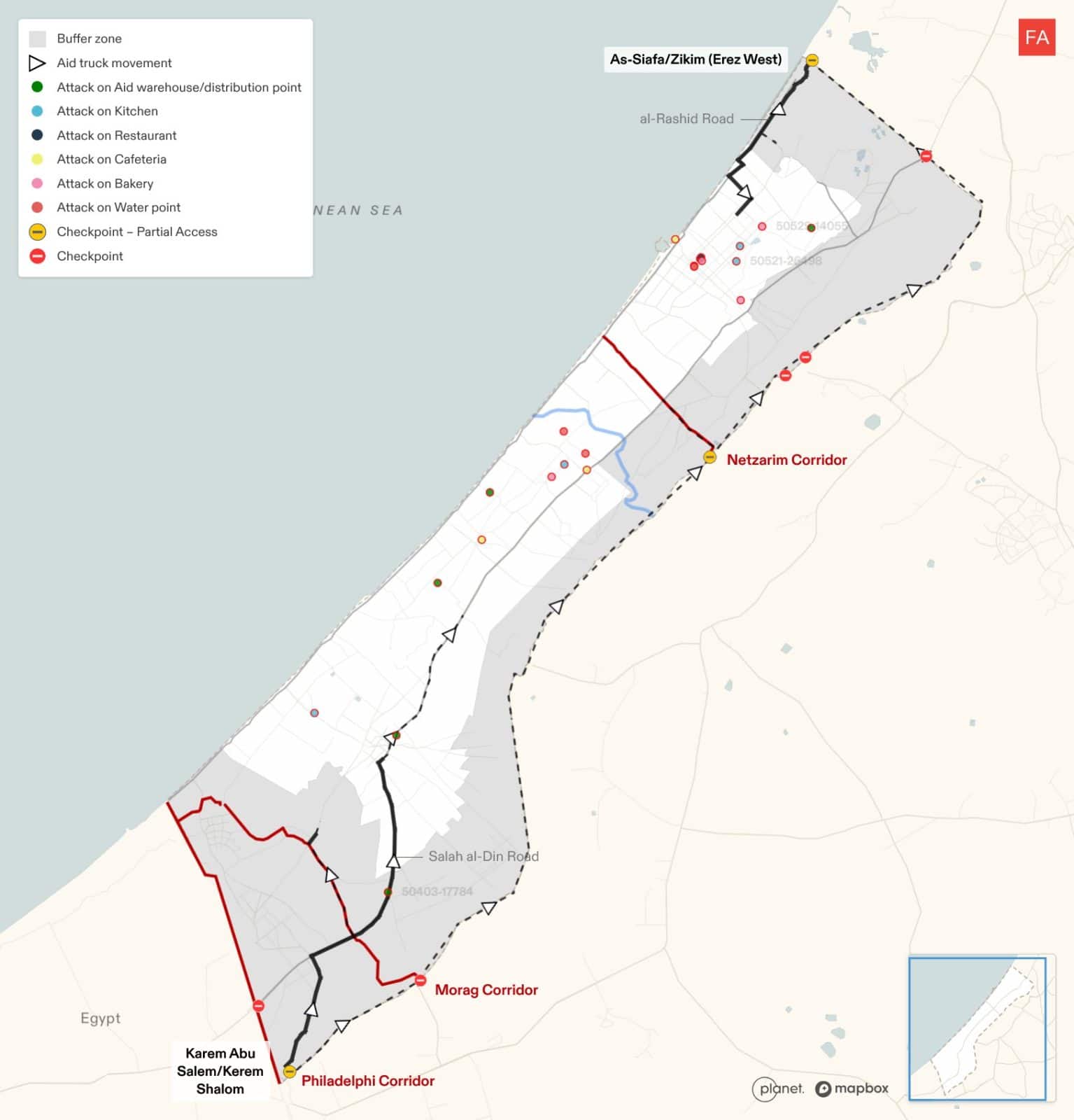
All access points for aid into Gaza have been under Israeli control for the entire period of Israel’s military campaign and continue to be as of the date of publication, meaning that Israel dictates what aid can enter Gaza. As demand increases and people become desperate, protecting aid routes is essential to ensure that the limited aid entering Gaza is distributed fairly, and not being diverted. We documented incidents of aid being diverted by desperate civilians, gangs and Israeli-backed groups, as well as instances of the Israeli military attacking individuals responsible for protecting and distributing aid, and failing to prevent the diversion of aid within Israeli military-controlled areas:
- 9 Israeli attacks on aid workers and the police assigned to protect aid routes.
- 37 incidents of aid diversion by desperate civilians, gangs and Israeli-backed groups.
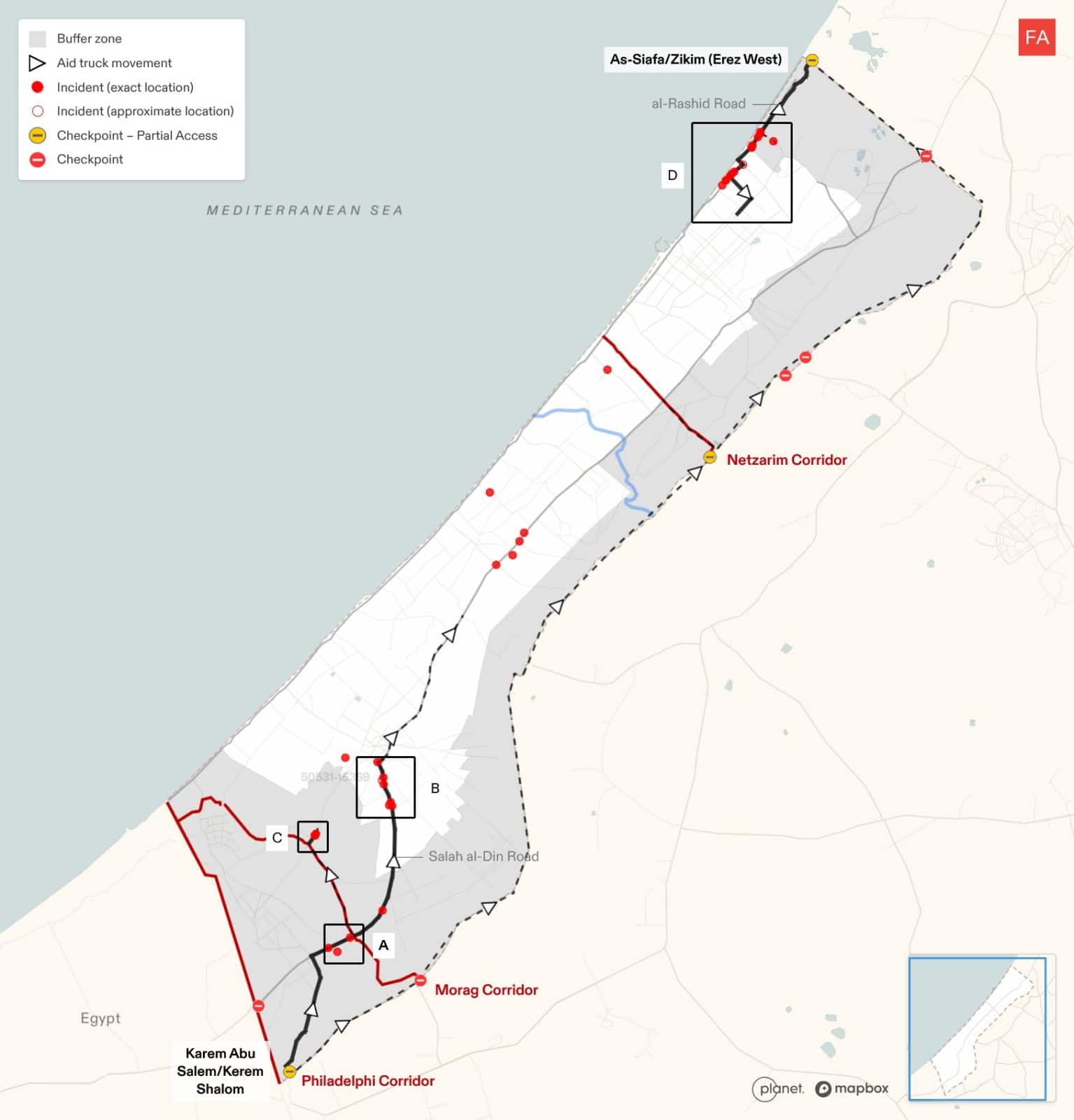
Imposing a military model
While undermining the civilian model, Israel has created dependency upon a military model of aid distribution that we have found is unsafe, and often deadly.
Each GHF ration station sits at the intersection of three types of infrastructure: supply routes for aid trucks, Israeli military routes and security outposts, and access routes for Palestinians arriving on foot. As seen at one of the ration sites in Rafah, the ‘entry’ route for Palestinians is divided into five narrow, fenced corridors. Perimeter security is provided by the Israeli military by way of outposts along the roads. Along the perimeter of each site, we have identified four watchtowers.
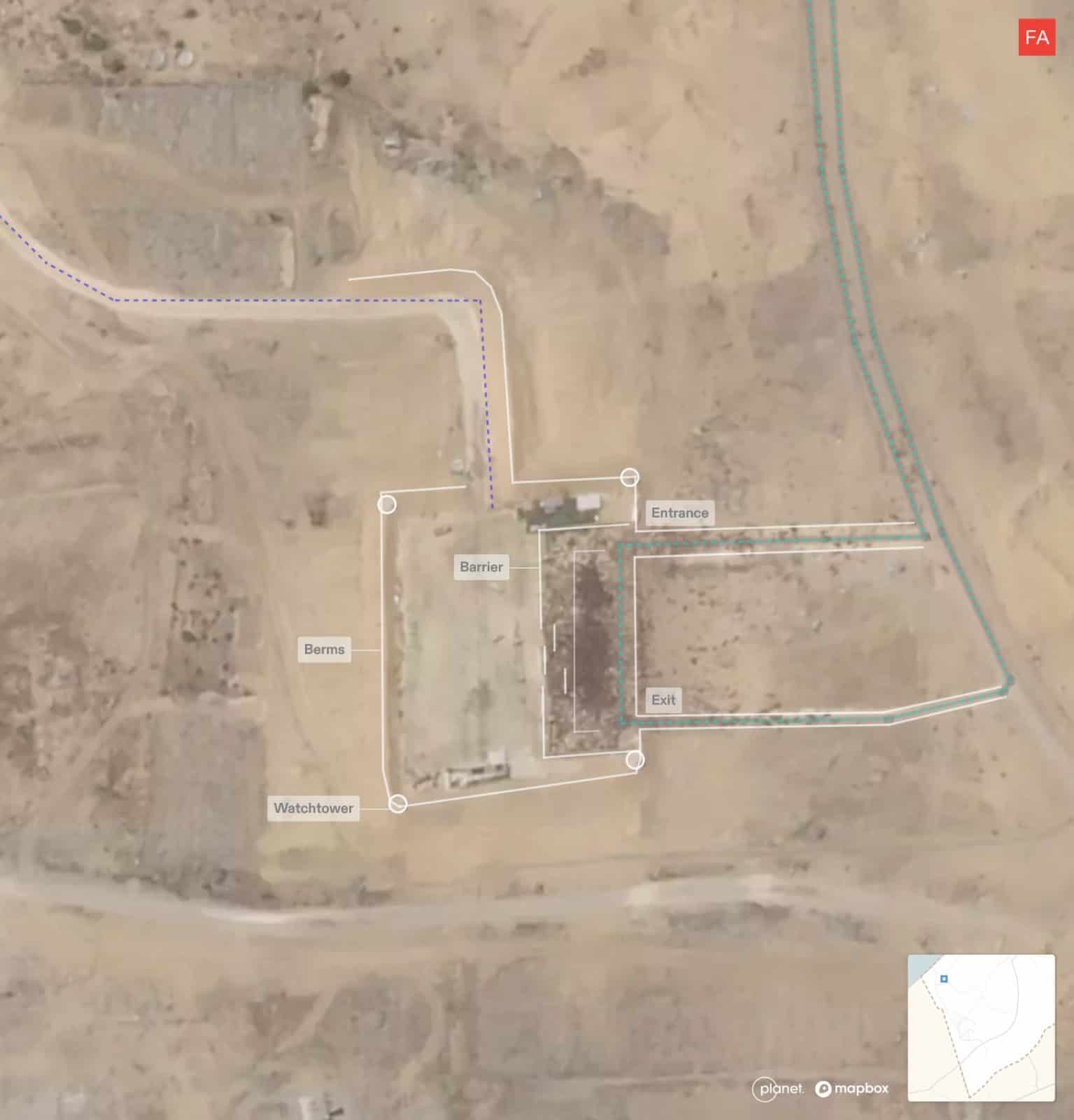
Our analysis of 160 announcements of opening and closing times of the GHF ration stations, posted on their official Facebook page between 29 May and 4 July 2025, found:
- 60% of the announcements were posted less than one hour before the facility opened. Palestinians need to walk 2.5-10km to reach the ration stations, making it unlikely they could arrive in time to access what little aid was available.
- The average duration a ration station was open for at one time was 23 minutes. After 19 June, this fell to 10 minutes.
- In 23% of cases, the closure of a site was announced before the previously communicated opening time.
- In 16% of cases, only the opening or closing time was communicated.
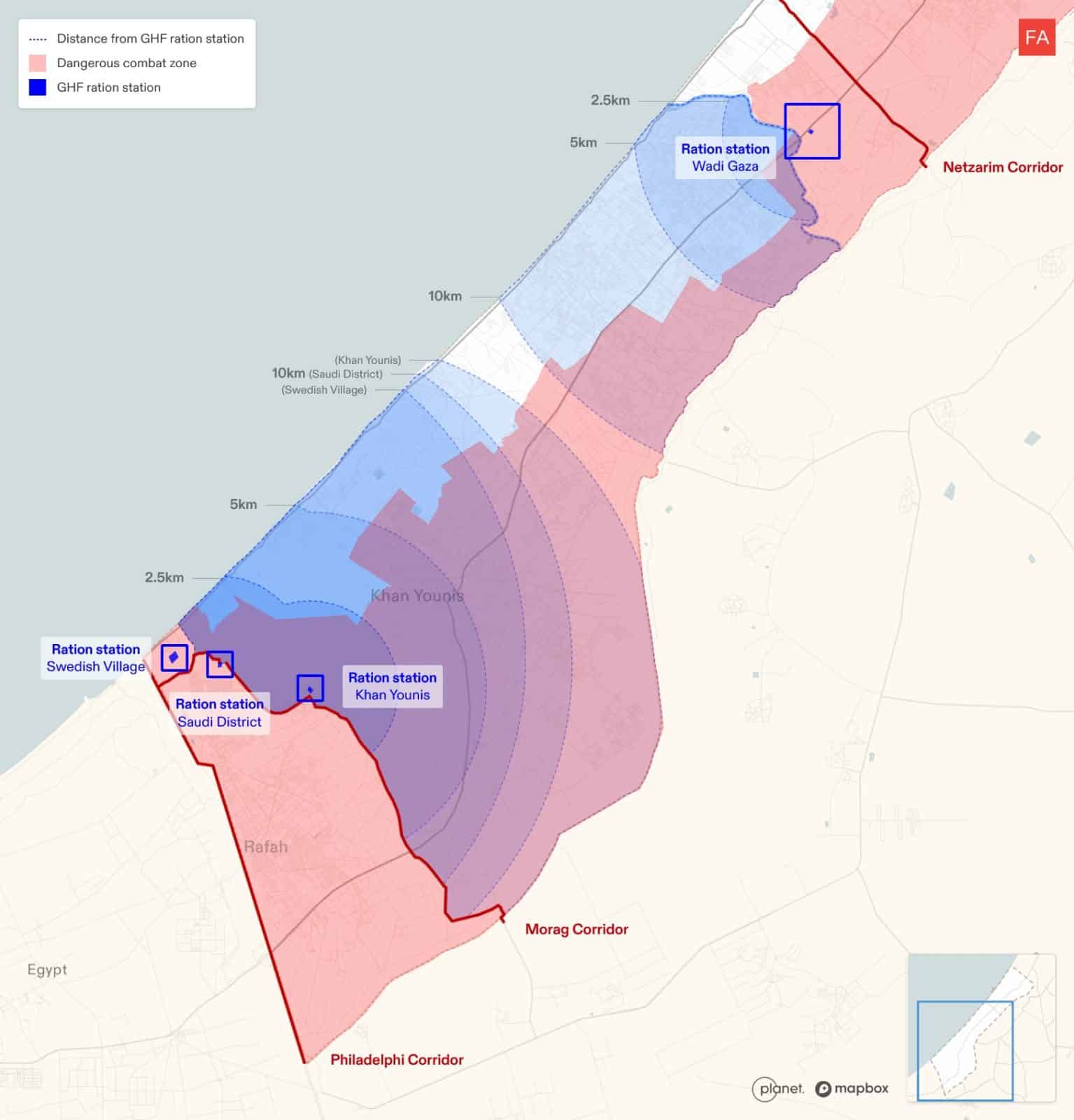
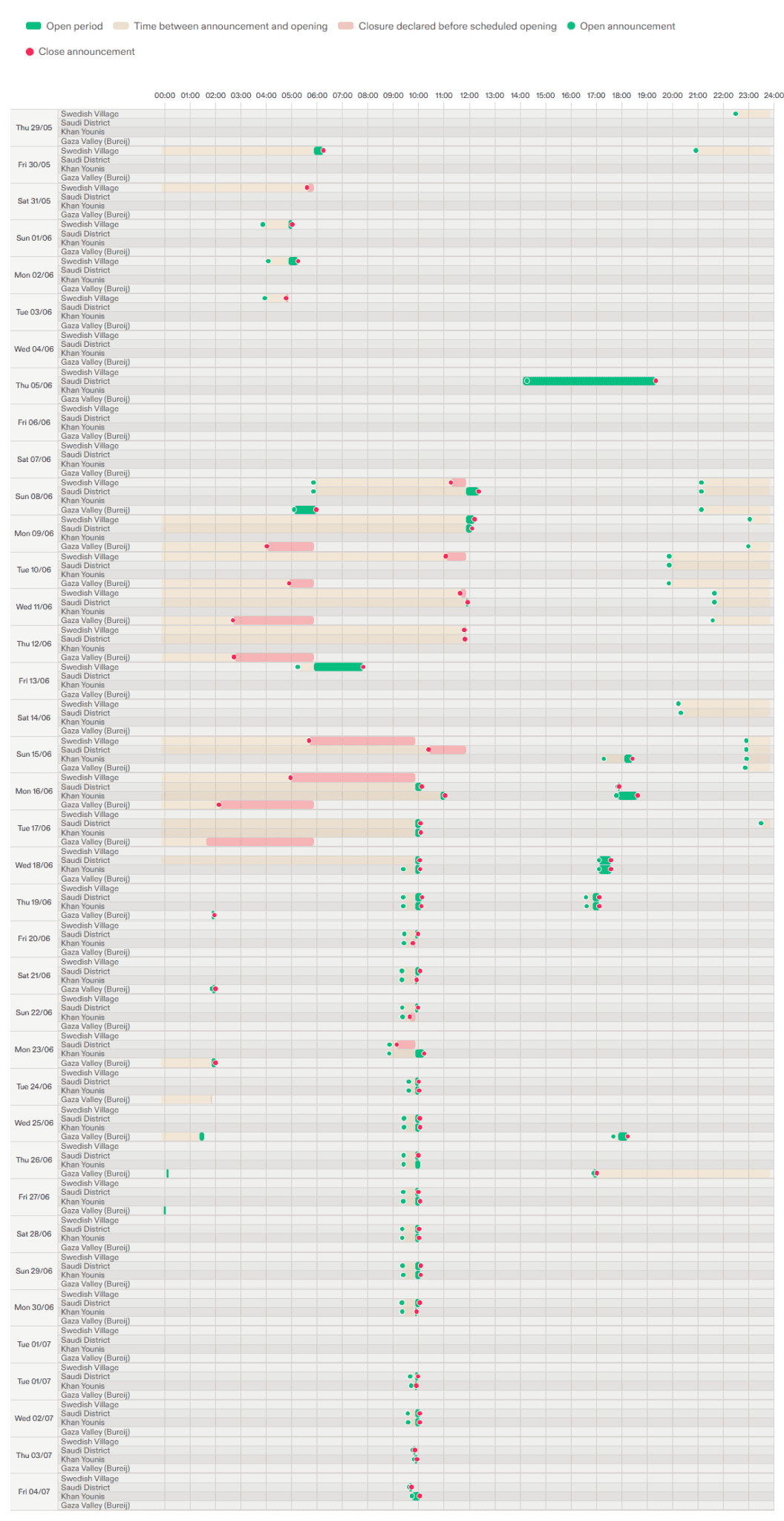
Airdropped aid can land in one of two locations: the 88% of Gaza under Israeli military control, in which the military have threatened violence against any Palestinian who enters, or the remaining 12% of land which now shelters Gaza’s entire population; these latter areas are densely populated, and we have documented multiple airdrops which have killed people and destroyed shelters.
Since July 2025, FA has verified video footage of 7 incidents relating to airdropped aid. In 4 of those, airdropped aid is visible in mid-fall; in the other 3, the aid is visible landing. All 7 incidents occurred within areas designated by the Israeli military as ‘no-go’ zones.
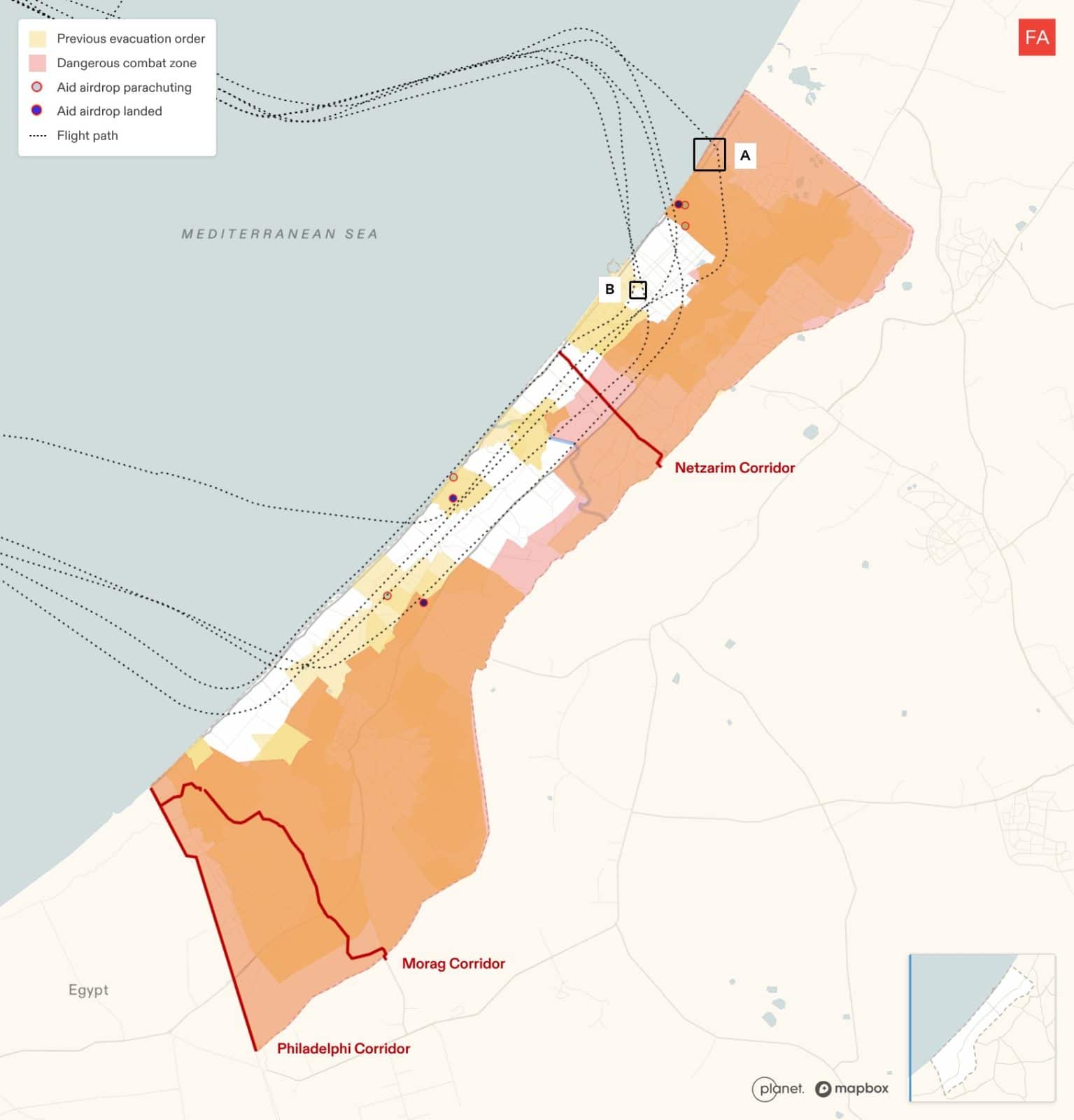
Patterns
Our analysis finds that the Israeli system of aid distribution has contributed to three patterns of event.
Forced displacement and re-concentration of the civilian population
We documented several ways in which the Israeli system of aid distribution has contributed to the forced displacement and re-concentration of Gaza’s civilian population in areas which put their lives at risk, and which cannot sufficiently support civilian life:
- Adoption of an aid distribution model that requires people to relocate closer to the GHF ration stations.
- Evacuation orders are forcing Palestinians into a state of perpetual displacement. Areas to which people were ordered to evacuate were later attacked, and areas under evacuation orders are being absorbed by an expanding ‘buffer zone’ in which systematic demolition is occurring.
- Failure to provide safe spaces for civilians while continuing to strike the previously designated ‘Humanitarian Zone’ in the al-Mawasi area.
- Proxy actors encouraging Palestinians to relocate, using incentives of shelter.
Quantitative findings:
- 58 evacuation orders from the Israeli military.
- As of 27 July, the ‘Dangerous combat zone’ designation covered 79% of Gaza. Evacuation orders for these areas say: ‘Returning to dangerous zones puts you in danger’.
- Between 18 March and 26 April 2025, 6 attacks on areas to which civilians were ordered to relocate. Each attack took place between 6 and 36 hours after the evacuation order was given.
- Since 18 March, 31 attacks on the previously declared ‘humanitarian zone’ of al-Mawasi, which shelters a growing number of displaced Palestinians.
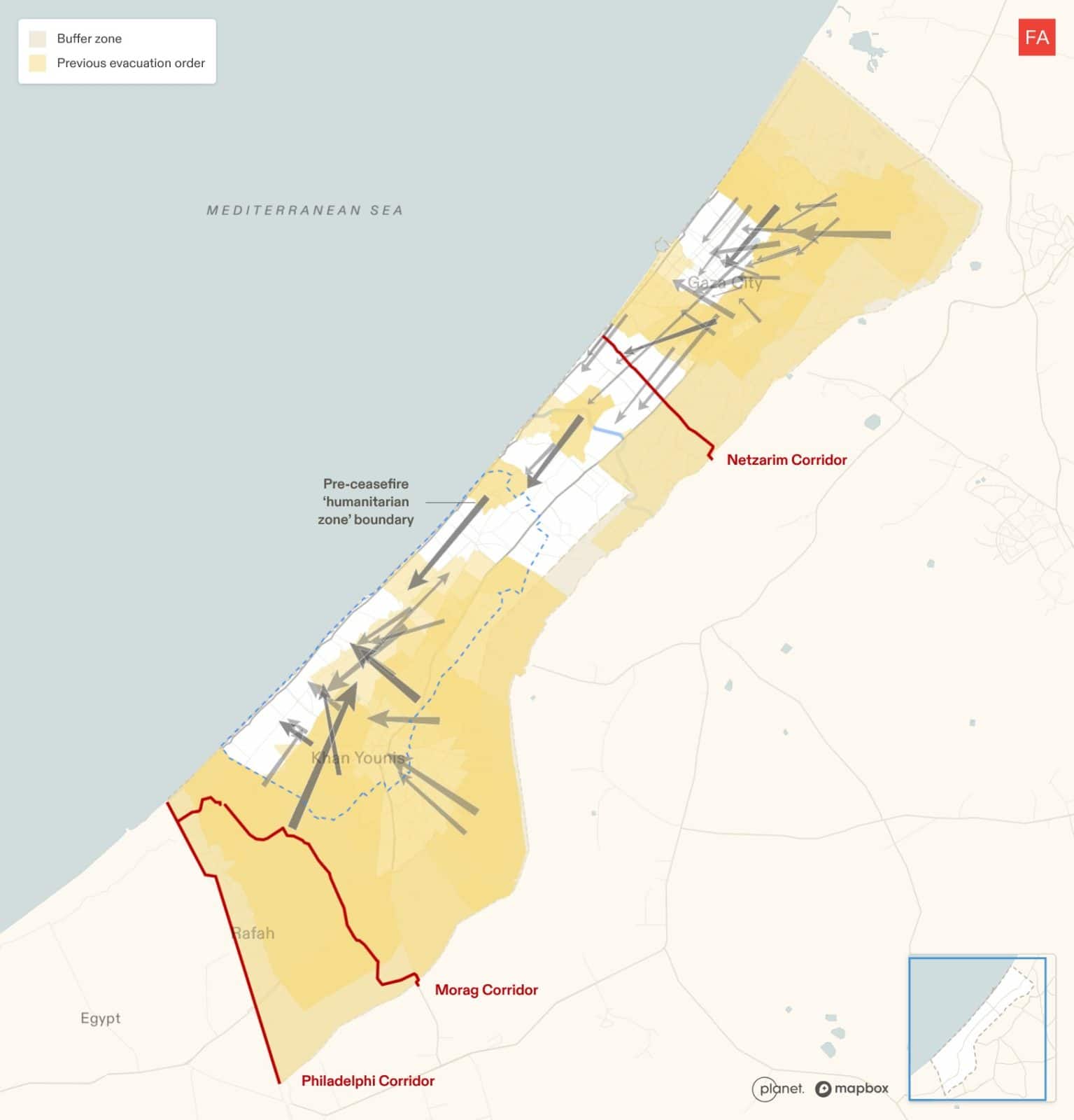
Reaching aid is dangerous and deadly
We identified a pattern in which civilians were repeatedly attacked while seeking aid. We verified 58 incidents of Israeli military attacks on civilians seeking aid, including:
- 19 attacks in proximity to aid routes.
- 25 attacks around the GHF ration stations, between 29 May and 1 August. Of these, 20 occurred along the routes the GHF instructed civilians to use to reach the sites.
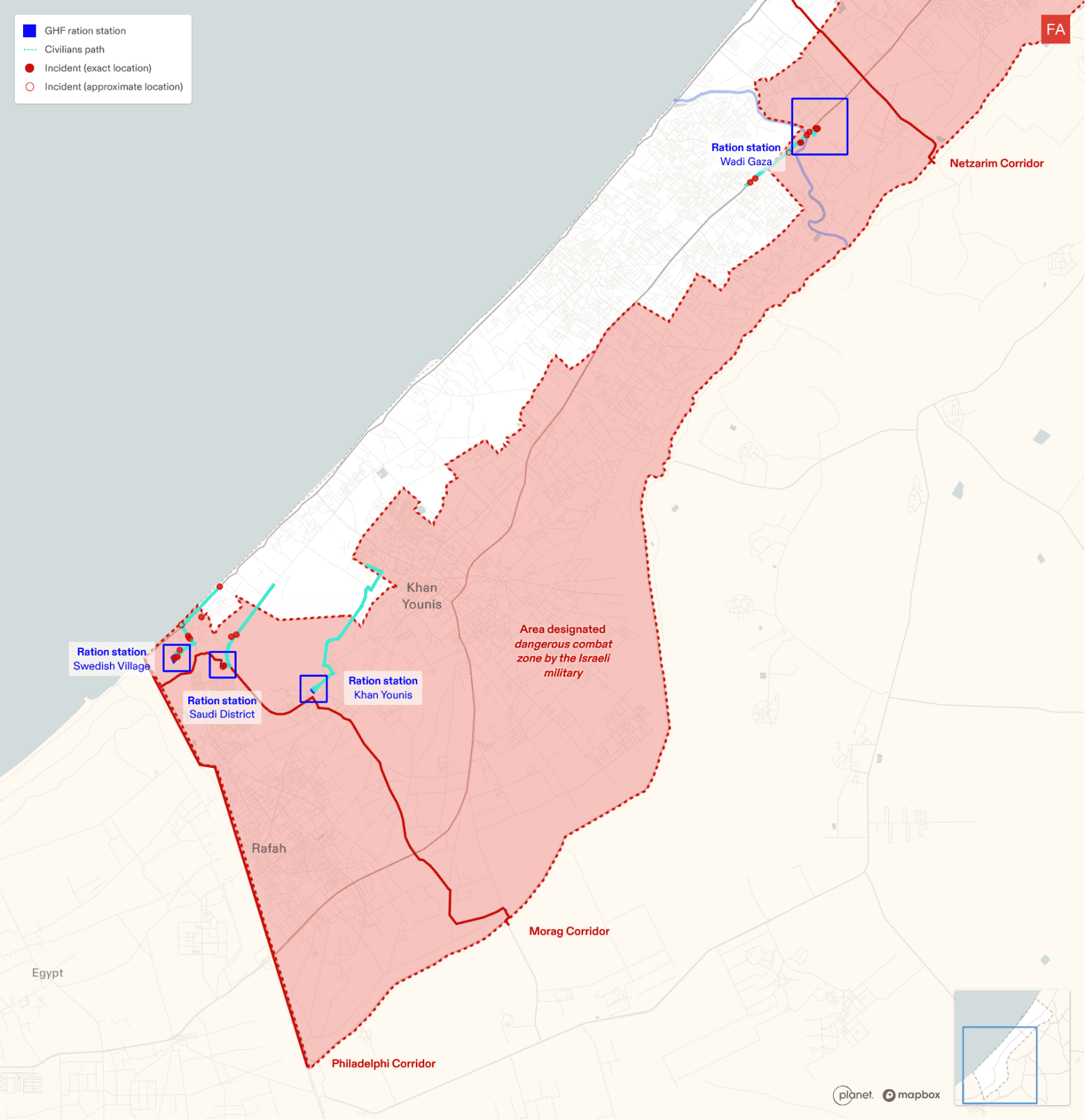
Undermining civil order and dismantling the social fabric
The incidents we documented show that Israel is undermining the civil order and dismantling the social fabric in Gaza by:
- Operating an aid distribution which provides insufficient rations, creating desperation which is exacerbating civil disorder.
- Supporting groups who steal aid, like the Abu Shabab group.
- Attacking those tasked with protecting aid, like the Palestinian police under Gaza’s Interior Ministry, and aid workers.
- Preventing civilian efforts to protect aid convoys.